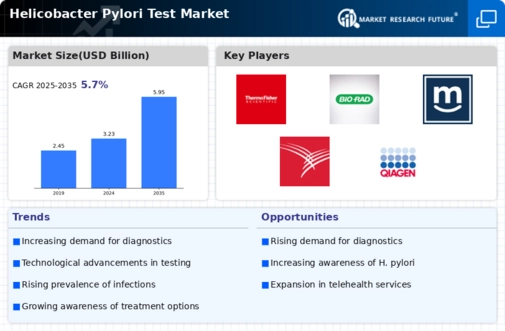Market Share
Helicobacter Pylori Test Market Share Analysis
The H. pylori test market is a crucial segment within the diagnostic industry, focusing on detecting the presence of Helicobacter pylori bacteria in the digestive system. With a prevalence of H. pylori infections globally, the market for these tests has witnessed significant growth, prompting companies to adopt diverse positioning strategies. Market share positioning refers to the conscious actions by firms aimed at creating a unique footprint and commanding large shares of markets. The H. pylori test market is characterized with different strategies used by companies in the effort to enhance their market share depending on factors like accuracy, convenience and affordability among others. The first important strategy is based on the results accuracy positioning of products. Business organizations put their money in R n D to increase accuracy of H. pylori tests which health practitioners and the patients can trust for diagnosis decisions made with precision. This accuracy focus ensures credibility and fosters trust among end-users. Competitive pricing is another crucial strategy in market share placement. Companies endeavor to provide budget-friendly H. pylori testing services without sacrificing quality. This method meets the needs of a wider range of customers who include those healthcare facilities that are constrained by limited budgets; in turn, market penetration is enhanced. The fact that manufacturers promoted H. pylori testing kits as easy-to-use and convenient contributes largely to the market share growth. The kits can be accessed by a larger audience such as individuals at home conducting tests themselves and the simplified procedures involved in opening these kits hence ease of use. This method coincides with global decentralization of healthcare and self-diagnosis. Firms customize their positioning strategies in a bid to work with particular demographic. This may include targeting areas with higher endemicity of H. pylori or tailoring marketing approaches to specific age groups. Through recognizing the peculiar needs of various sections, companies can maximize their market share in some particular niches. The inclusion of H. pylori testing into the larger digital health environment is a modern approach for it. Companies then integrate their test solutions onto digital platforms harnessing direct data exchange, remote monitoring of patient health status and electronic health record connectivity. This approach does not only improve the value proposition overall but also fits with new ways in health technology. Market share positioning is profoundly influenced by educational campaigns. Companies promote awareness programs to sensitize the health care professionals and laymen on H. pylori testing as a way of curbing diseases such us stomach ulcers, cancers among others. Companies can encourage demand and establish market dominance by placing their products as part of preventive health care. Regulatory compliance and standards maintenance is the foundation of market share positioning. Companies that follow strict regulatory guidelines and make quality assurance a top priority earn loyal customers among the healthcare providers as well as end-users, resulting in sustainable market leadership.
Strategic collaborations and partnerships can enhance market share positioning. Companies may collaborate with healthcare institutions, laboratories, or pharmaceutical companies to expand their reach and influence within the H. pylori testing market. Such alliances can lead to the development of innovative solutions and joint marketing efforts.









Leave a Comment